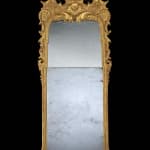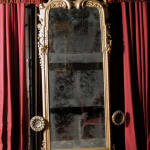THE GODOLPHIN PIER GLASSES ATTRIBUTED TO JOHN BELCHIER
Width: 34” / 86.25cm
Further images
-
(View a larger image of thumbnail 1
)

-
(View a larger image of thumbnail 2
)

-
(View a larger image of thumbnail 3
)

-
(View a larger image of thumbnail 4
)

-
(View a larger image of thumbnail 5
)

-
(View a larger image of thumbnail 6
)

-
(View a larger image of thumbnail 7
)

-
(View a larger image of thumbnail 8
)

-
(View a larger image of thumbnail 9
)

Provenance
Possibly supplied to Francis Godolphin (1678-1766), 2nd Earl of Godolphin for Godolphin House, Cornwall or Stable Yard, St. James’ Palace, London
Possibly by descent in Godolphin family until the 20th century
Henry Francis Dupont, Winterthur Museum, Delaware, USA
Sold Christie’s New York, 2nd February 1991, lot 208 (USD $143,000)
Literature
Bowett, A., Early Georgian Furniture 1715-1740 (Woodbridge, 2009) p. 292, plates 6:50-1
Child, G., World Mirrors 1650-1900 (London, 1990), p. 78, fig. 51
Cornforth, J., Early Georgian Interiors (London, 2004), pp. 280-85
Edwards, R. and Jourdain, M., Georgian Cabinet-Makers, rev. ed. (London, 1946) p. 99, fig. 33
COMPARE
Pier glasses supplied by Belchier in 1723 and 1726 for John Meller, Erddig Hall, Wales (NT 1146961 & NT 1146960)
Mirror attributed to Belchier in the Metropolitan Museum of Art, New York (Accession No. 46.116)
Mirror illustrated Synge, L., Mallett’s Great English Furniture (London, 1991), p. 89, fig. 94
Publications
Beard, G. and Goodison, J., English Furniture 1500-1840 (Oxford, 1987), p. 67, fig. 4
An exceptional pair of George I gilt-gesso pier glasses, each with divided and bevelled plates within a stepped frame carved with gadrooning, strapwork and foliage issuing eagles’ heads, the cresting with strapwork on a punched ground and scrolls centering a winged putto surmounted by a dolphin between scrolls in the pediment.
The present mirrors compare very closely with the two pier glasses supplied by John Belchier (1699-1753) to John Meller for Erddig Hall, Wales, on 15th July 1723 (NT 1146961) and 6th June 1726 (NT 1146960) for the two best bedchambers at costs of £36 and £50 respectively.
The earlier mirror features the same shallow-relief strapwork and stepped rectangular form as the present mirrors. The 1726 mirror is nearly identical, with these features in addition to bold central scrolls, gadrooning, carved foliage on the sides issuing eagles’ heads of identical posture and foliage at the bottom corners. The cost of £50 for this single piece, a huge sum, provides an idea of the price the present pair will have commanded.
The mirrors also compare closely with Belchier’s attributed work, namely a mirror from the Untermyer Collection now in The Metropolitan Museum of Art, New York (Accession No. 46.116) and another formerly in the collection of Gerald Hochschild (illus. Synge, Mallett’s Great English Furniture, 1991, p. 89, fig. 94), which both feature a stepped plate, scrolls, eagles’ heads and acanthus leaves of identical drawing to the present mirrors.
John Belchier was one of the most important cabinet-makers of the early eighteenth century, described in the London Evening Post on his death as ‘for many years past a very eminent cabinetmaker’. Erddig Hall is his most significant known commission. In addition to the mirrors, he likely supplied the State Bed in 1720 which features eagles’ heads on the tester, prefiguring the same on the 1726 pier glass and matching those on the present mirrors.
During the same time Belchier received orders for glass from St. Paul’s Cathedral. Accounts dated December 1724 to January 1725 record 8 glasses 25 inches square at £8 and 27 others 25 by 18 inches at 16s each (£21 12s). Among clients of the 1730s and 40s were the Earls of Radnor of Longford Castle to whom Belchier is reputed to have supplied a pair of japanned bureau-bookcases, another type of furniture, like walnut case furniture, some surviving with his trade label, with which his workshop is often associated.
The dolphin naiant in the pediments of the mirrors indicates that they were made for a particular patron, in this case possibly Francis Godolphin (1678-1766), 2nd Earl of Godolphin. The dolphin naiant has been the heraldic symbol of the Godolphins of Rialton and Helston since at least the sixteenth century, as a reference to the family name and substantial landholding in Cornwall. A dolphin naiant as it appears in the mirrors’ crests is first seen in the arms of the 2nd Earl’s father, Sidney Godolphin, 1st Earl (1645-1712), and the mirror carvings are very possibly modelled on the pair of carved, parcel gilt and painted wooden dolphins naiant (NT 169408) thought to have originally served as helmet crests for Sir William Godolphin (c.1518–70).
The 2nd Earl was a prominent politician and courtier during the lifetime of Belchier, serving as an MP and later as a Peer. He was Lord of the Bedchamber to both George I and George II, and in 1733 appointed Governor of the Scilly Islands. Prominent in London social circles, Godolphin will have been familiar with the most accomplished and fashionable cabinet-makers in the city at the time. His uncle, Dr Henry Godolphin, was Dean of St. Paul’s where Belchier supplied glasses and his workshop was located, and it is possible that it was through this connection that Godolphin commissioned the present mirrors.
Francis Godolphin was born to the titan of late seventeenth and early eighteenth-century politics, Sidney Godolphin (1645-1712), 1st Earl, who under Queen Anne assumed such prominence alongside his chief ally John Churchill that the two were named ‘the Duumvirs’. In March 1698, he married Lady Henrietta, eldest daughter of Churchill, the victor of Blenheim, first duke of Marlborough and ancestor of Winston Churchill.
Francis was one of the founding governors of the Foundling Hospital, a London orphanage charity created to tackle the problem of child abandonment. He also had the distinction of owning one of the founding thoroughbred sires, the Godolphin Arabian.
It is said that he only read two works, Burnet’s History of my own Time and Colley Cibber’s Apology. When he had perused them throughout, he began them again. Francis died at his house in St James’ on 17th January 1766 and was buried in Kensington Church, just down the road from the Rolleston Gallery.








